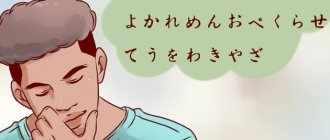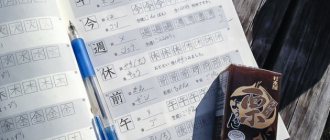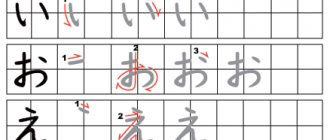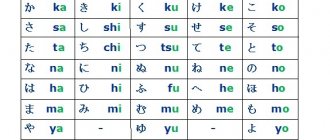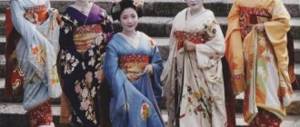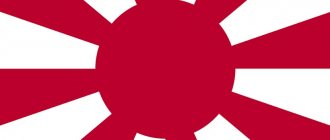Ask the first person you meet: “What Japanese monsters do you know?” Most of the time you will hear: “Godzilla, Pikachu and Tamagotchi.” This is still a good result, because Russian fairy-tale creatures, through the eyes of the average Japanese, are something between a matryoshka, Cheburashka and a drunken polar bear. But Russian and Japanese cultures can boast of such ancient menageries that some American Paul Bunyan never even dreamed of. “World of Fantasy” has already taken a walk along the unknown paths of Slavic myths, studying the traces of unprecedented animals. Today we will travel to the opposite side of the planet and see what bizarre creatures live under the rays of the rising sun.
You can't understand Japanese folklore without a bottle of sake. It was formed thanks to the centuries-long “collaboration” of Chinese Buddhism and national Shintoism - a unique process during which the principles of one religion were complemented by the commandments of the other.
Such syncretism gave rise to an amazing interweaving of myths: Buddhist deities preached Shintoism, and primitive Shinto magic did not at all contradict the complex Buddhist picture of the world. To understand the uniqueness of this phenomenon, it is enough to imagine the idol of Perun in the altar of a modern Orthodox church.
The peculiarities of the national worldview, coupled with Buddhist mysticism and the remnants of primitive beliefs, made Japanese monsters completely different from their Western “colleagues.” Ghosts settled next to people and animals under the red sun - something like fairies in their classical European understanding, but unlike each other and successfully replacing all the chimeras invented by humanity.
Hiyakki Yako, the annual ghost parade. It is better not to go outside at this time.
Japanese ghosts are not restless souls of the dead or clots of protoplasm from parallel worlds. The concept of obake, derived from the verb bakeru - to transform, to transform, is most often applied to them. Obake may well be creatures of flesh and blood. The main thing about them is that these “ghosts” turn from one thing to another, changing symbols and meanings, and also disrupting the natural course of things.
Yokai and Samurai (artist Aotoshi Matsui).
Supernatural horror in Japanese culture is focused not on some otherworldly objects, but on the irrational modification of familiar forms.
A skeleton in a white shroud, glowing eyes in the dark and an eerie howl in a cemetery will frighten a Japanese much less than a crumpled paper lantern or strange television interference. The basis for such fears is a simple (if not primitive) picture of the world. Similar “horror stories” about a black hand or a white sheet were once in great demand in the Ogonyok magazine. From obake, an independent class of ghosts is sometimes distinguished - youkai (Japanese folklore terminology is very confusing and there is simply no single classification). Their main feature is their unusual appearance (one eye, long neck, etc.). Yokai resemble Russian brownies or goblins. These creatures live in a certain area and do not seek to meet humans. Yokai can be either friendly or malicious. They are associated with fire and the northeast. In winter, encounters with evil spirits are rare.
In the vastness of Japan, you can also find quite normal ghosts of yurei - souls deprived of peace. Shintoism teaches that after death the soul waits for the necessary rituals to be performed on the body, after which it safely departs for the next world. The deceased spirit can meet living relatives once a year - in July, during the Bon holiday. But if a person dies a violent death, commits suicide, or if the rituals over his body are performed incorrectly, the soul turns into a yurei and gains the opportunity to penetrate the world of the living. Yurei can be found at the place of his death, but you should not strive for this, because the main occupation of the restless ghosts is revenge.
Most yurei are love-stricken women. Initially, the Japanese believed that their appearance was indistinguishable from their lifetime, but soon traditions began to change, and instead of a face, the ghostly lady could have a huge eye.
Today the appearance of yurei is standardized. They are dressed in a white funeral kimono. The hair is jet black, long (supposed to grow after death) and flowing over the face. The arms hang helplessly down, instead of legs there is emptiness (in the Kabuki theater actors are suspended on ropes), and otherworldly lights curl next to the ghost.
Sadako ("The Ring")
Kayako ("Malice")
The most famous yurei in the West are Sadako (“Ring”) and Kayako (“Anger”).
In the animal world
As far as common animals are concerned, Japanese fairy tales are very similar to European ones. “Don’t kill me, I’ll be useful to you,” said animals in different parts of the planet. The universal commandment “thou shalt not kill” was especially relevant for Buddhism. As a reward for mercy towards animals, the main character received wealth or magical abilities. Little frogs rushed to the aid of their saviors, orphaned ducks convinced the evil hunter to give up his craft - after all, it is unknown who he will be reborn into in his next life.
Azuki-arai. In Asia, adzuki beans were always boiled with sugar and were a kind of candy.
Abumi-guchi : When a warrior died in battle, the stirrups from his horse were sometimes left on the battlefield. There they came to life, turning into a strange furry creature, forever searching for its missing owner.
Abura-akago : souls of merchants who, during their lifetime, sold oil stolen from lamps at roadside shrines. They fly into the room like clots of fire and turn into a baby who sucks all the oil out of the lamp, after which they fly away.
Azuki-arai : a little old man or woman washing beans in mountain streams. Sings threatening songs (“Should I wash beans or eat someone?”), but is actually shy and harmless.
Aka-name : “dirt licker” appears in those baths that have not been cleaned for a long time. As its name suggests, it feeds on unsanitary conditions. Its appearance quickly instills in people the habit of cleaning up after themselves in washrooms. His relative, the long-legged tenyo-name, licks the dirty ceilings.
Aka-name. The tongue will take you to the bathroom.
Ama-no-zako : born from the rage of the thunder god Susanoo. Ugly, has strong teeth that bite through steel. Can fly quickly over long distances.
Ama-no-zaku : An ancient demon of stubbornness and vice. Reads people's thoughts, makes them act in such a way that their plans are accomplished exactly the opposite. In one of the fairy tales, he ate a princess, put on her skin and tried to get married in this form, but was exposed and killed.
Ame-furi-kozo : spirit of rain. Appears in the form of a child covered with an old umbrella and carrying a paper lantern in his hands. Loves to splash in puddles. Harmless.
Ami-kiri : There are a lot of mosquitoes and ghosts in Japan during the summer. One of them, looking like a cross between a bird, a snake and a lobster, loves to tear up mosquito nets, as well as fishing gear and drying clothes.
Ao-andon : During the Edo period, people would often gather in a room, light a large blue lantern with a hundred candles, and begin telling scary stories to each other. At the end of each of them, one candle was extinguished. After the hundredth story, the light went out completely and ao-andon appeared.
Ao-bozu : a short cyclops who lives in young wheat and drags children there.
Ao-niobo : an ogress who lives in the ruins of the imperial palace. During her lifetime she was a maid of honor. Distinguished by black teeth and shaved eyebrows.
Ao-sagi-bi : analogue of the Firebird: a heron with fiery eyes and white luminous feathers.
Asi-magari : ghostly raccoon dog. At night, it wraps its tail around the legs of travelers. Her fur feels like raw cotton.
Ayakashi : A sea serpent about two kilometers long. Sometimes it floats over boats, forming an arch with its body. This can last for several days, during which the people in the boat are busy scooping out the mucus that oozes profusely from the monster.
Baku : Chinese chimera with the body of a bear, the trunk of an elephant, the eyes of a rhinoceros, the tail of a cow, the paws of a tiger and a spotted skin. Feeds on dreams. If you see a bad dream, you should call on the tank, and it will absorb it along with all the foreshadowed troubles.
Baku. Goodnight to you. Bon appetit to him.
Bake-zori : Old sandalwood that has not been well cared for. Runs around the house and sings stupid songs.
Bake-kujira : a whale skeleton accompanied by strange fish and ominous birds. Invulnerable to harpoons.
Bake-neko : If a cat is fed in the same place for 13 years, it will turn into a bloodthirsty werewolf. Bake-neko can be so huge that it will not fit into the house, but instead will rummage around with its paws, looking for people like mice in a hole. Sometimes a werewolf takes on the appearance of a human.
There is a well-known story about how a cat disappeared in one house. At the same time, the behavior of the mother of the family began to change: she avoided people and ate, closing herself in the room. When the household decided to spy on her, they discovered a creepy humanoid monster. The owner of the house killed him, and a day later she again turned into the missing cat. Under the tatami on the floor, the mother's bones were found, gnawed clean.
Cats in Japan were associated with death. Therefore, people were very suspicious of cats of deceased owners. These animals could become kasa, stealing corpses, or two-tailed nekomata, playing with dead bodies like dolls. To avoid such a disaster, kittens need to have their tails docked (so that they do not fork), and the deceased's cat should be securely locked up.
The image of a cat was not always gloomy. Porcelain maneki-neko figurines bring success to store owners. During a thunderstorm, the cat led the rich man away from the tree that was about to be struck by lightning, after which he began to patronize the temple. One geisha's cat did not allow her owner into the restroom where the snake was hiding. Finally, cats often took the form of people and became the wives of single men or the children of childless couples.
Basan. It was found in the territory of modern Ehime Prefecture.
Basan : overgrown rooster. At night he walks the streets and makes a strange noise - something like “bass-bass”. People look out of their houses, but find no one. Can breathe fire, but is generally harmless.
Betobeto-san : when you are walking down the street at night and hear footsteps behind you, but there is no one behind you, say: “Betobeto-san, please come in!” The ghost will leave and will no longer stomp behind you.
Gyuki (Yushi-oni) : A bull-like chimera that lives in waterfalls and ponds. Attacks people by drinking their shadows. After this, the victims begin to get sick and soon die. Gyuki's steps are silent. Having identified a victim, he will pursue it to the ends of the Earth. There is only one way to get rid of the monster - by repeating the paradoxical phrase: “Leaves drown, stones float, cows neigh, horses moo.” Sometimes gyuki takes the form of a beautiful woman.
Jore-gumo : During the day, she looks like a pretty girl, but at night she turns into a spider-like monster that lays webs on people.
Jubokko : Trees growing on battlefields soon become accustomed to human blood, becoming predators. They catch travelers with branches and suck them dry.
Doro-ta-bo : the ghost of a peasant who spent his whole life cultivating his piece of land. After the death of the owner, the lazy son abandoned the plot, and it was soon sold. The father's spirit regularly rises from the ground and demands that the field be returned to him.
Inugami : if you tie a hungry dog, put a bowl of food in front of it so that it cannot reach it, and when the animal reaches the highest point of frenzy, cut off its head, you get an inugami - a cruel spirit that can be set on their enemies. Inu-gami is very dangerous and can attack its owner.
Inu-gami.
In one legend, a dog's head was sawed off with a dull bamboo saw. Ippon-datara : a blacksmith spirit with one leg and one eye.
Isonade : giant fish. It knocks sailors into the water with its tail and devours them.
Ittan-momen : At first glance, it appears as a long piece of white material floating in the night sky. It may not come to a second glance, since this spirit likes to silently fall on a person, wrap itself around his neck and strangle him.
Itsumaden : When a person dies of hunger, he turns into a huge fire-breathing bird with a snake tail. This spirit haunts those who refused him food during life.
Kama-Itachi : If you are caught in a storm and find strange cuts on your body, this is the work of a Kama-Itachi, a storm stoat with long claws.
Kameosa : An old sake bottle that magically produces alcohol.
Kami-kiri : a spirit with claws that attacks people in bathrooms and cuts off their hair at the root. Sometimes in this way he tries to prevent the marriage of a person with an animal or spirit.
Karakasa-obake, an old umbrella that came to life. Safe
Kappa (kasambo) : one of the most common Japanese perfumes. He has many faces, but always has a recess with water on his head, where all his magical power is hidden. People often trick the kappa by bowing and forcing him to make a return bow that spills water. Lives in water, loves cucumbers. It is recommended not to eat them before swimming, otherwise the kappa may smell the treat and drag you to the bottom. Naughty children are taught to bow under the pretext that it is protection from the mouthguard.
Kappa
Kijimuna : good tree spirits. There's only one thing you can do to make them angry: an octopus.
Kirin : sacred dragon. It differs from the Chinese qi-lin only in that it has three toes instead of five on its paws.
Kitsune : a werefox, a popular character in romantic fairy tales. Often turns into a girl and starts families with people. Loves to steal and cheat. As foxes age, they grow additional tails (their number can reach up to nine). Kitsune magic does not affect Taoist monks.
You can identify a kitsune by its shadow - it always has the outline of a fox.
Japanese demons
In the Land of the Rising Sun, demons are called Oni, and the game of tag is called Onigokko (game of Oni). They live in Hell, are strong and evil, difficult to kill and can quickly regrow body parts severed by the hero. Their favorite weapon is a heavy iron spiked club, and their favorite dish is human flesh. Myths say that a person who does not control anger becomes an oni. The eternally hungry demons are called gaki. Gakis come from gluttons and those who waste food. On earth they turn into cannibals. The powers to protect humanity from demons are possessed by me-o - special warriors with secret knowledge.
Bakemono is the second type of evil creature from Japanese mythology. They are ugly, live in the darkness of mountain caves, near villages, and live in large groups. Bakemono use their teeth and are wary of Buddhist temples.
They are the demons of the Land of the Rising Sun
This is interesting
- The Japanese believe that a cat has the greatest chance of becoming a werewolf. That is why she should not be allowed to dance, thus demonstrating magical power.
- The highest chances of meeting a ghost in Japan are between 2 and 3 a.m. in the summer, when the border between the world of the living and the dead is thinnest.
- "Kitsune" means either "always red-haired" or "come to the bedroom." Foxes' favorite food is tofu. A person who has gotten rid of his obsession with the fox (penetrating under his fingernails or through his breasts) will have an aversion to tofu for the rest of his life.
- Rain falling in bright sunshine is called a “kitsune wedding” in Japan.
Ko-dama : spirit of the old tree. Likes to repeat human words. It is because of the ko-dam that an echo appears in the forest.
Ko-dama (anime "Princess Mononoke").
Konaki-diji : a small child crying in the forest.
If someone picks him up, Konaki-diji begins to rapidly gain weight and crushes his savior. Karakara-ona : an ugly mockingbird that chases people and torments them with her laughter.
Lidara-elbows : a giant of incredible size. His footprints became lakes. He often moved mountains from place to place.
Namahage
- “Santa Claus is the opposite.” Every New Year he goes from house to house and asks if there are naughty children here. Little Japanese who believe in Namahage panic and hide, and their parents convince the demon that their children are good, after which they pour him one hundred grams of sake.
Ningyo : The Japanese mermaid is a hybrid of a monkey and a carp. The meat is very tasty. Having tasted it, you can extend your life for many hundreds of years. If a ningyo cries, it will turn into a human.
Raiju
Noppera-bo (noperapon) : a faceless spirit that frightens people.
Nuri-botoke : if you don’t take good care of your home Buddhist altar, then there will be a ghost in it that looks like a black Buddha with a fish tail and protruding eyes. Every time a careless believer wants to pray, he will be greeted by this monster.
They (emphasis on o): colorful demons - something like European trolls or ogres. Aggressive and angry. They fight with iron clubs. They are scared off by the smell of burnt sardines, but today in Japan it is customary to do this by tossing beans (which for some reason they hate), saying: “They go away, happiness comes!”).
Two rokurokubi.
Raiju is Raiden's pet. Represents ball lightning. He likes to hide in people's belly buttons, which is why the superstitious Japanese sleep on their stomachs during thunderstorms.
Rokuro-kubi : ordinary women who, for some reason, underwent a partial ghostly transformation. At night, their necks begin to grow and their heads crawl around the house, doing all sorts of nasty things. Rokuro-kubi is unlucky in love - because men are very nervous about such night walks.
Sagari : horse head rattling tree branches. If you met her, you could get sick (probably with a stutter).
Sazae-oni : old snails turned into evil spirits. They can turn into beautiful women. There is a well-known story when pirates rescued a drowned beauty. She happily gave herself to each of them. It was soon discovered that the men's scrotums were missing. Sazae-oni proposed a deal: the pirates give her all their gold, and the snail returns their scrotums (the Japanese sometimes call this organ “golden balls,” so the exchange was equal).
Sirime : Exhibitionist ghost. He catches up with people, takes off his pants and turns his back to them. An eye pokes out from there, after which spectators usually faint.
Soyo : cheerful alcoholic ghosts. Harmless.
Sune-kosuri : furry animals that throw themselves at the feet of rushing people and make them stumble.
Ta-Naga: The long-armed people of Japan who entered into a symbiosis with the Ashi-Naga (long-legged people). The first sat on the shoulders of the second and began to live together as a single organism. Nowadays you can no longer see these giants.
Tanuki : were-badgers (or raccoon dogs) that bring happiness. The amount of happiness is directly proportional to the size of a badger's scrotum. Tanuki know how to inflate it to incredible sizes (sleep on it, shelter from the rain with it), or even turn this part of the body into a house. The only way to verify the authenticity of a badger's home is to drop a burning coal on the floor. True, after this act you will no longer see happiness.
Tanuki and his dignity (Tsukioko Yoshitoshi, 19th century).
Tengu : winged werewolves. Despite the comical nose, like Pinocchio, they are extremely powerful and dangerous. A long time ago they taught people martial arts. If a person suffering from amnesia emerges from the forest, it means that he has been kidnapped by a tengu.
Futa-kushi-onna : An ever-hungry ghost of a woman with an extra mouth on the back of her head, a Japanese variant of Tantalus. The second mouth spits curses and uses its hair as tentacles, stealing food from the woman. According to one legend, this curse was imposed on an evil stepmother who deprived her adopted children of food.
Funayurei, ghosts of drowned sailors. They swim up to the ships and ask for a bailer. If you give it, they will sink the ship by filling it with water.
Haku-taku (bai-ze) : a wise and kind creature with nine eyes and six horns. Speaks human speech. One day, Bai Ze was captured by the great Emperor Huang Di and, in exchange for freedom, told him all the ins and outs about his relatives (11,520 types of magical creatures). The emperor ordered the testimony to be recorded, but, unfortunately, this bestiary has not reached our time.
An elephant catches a tengu (Utagawa Kuniyoshi, 19th century).
Hari-onago : an ogress with a powerful head of “living” hair, each of which ends in a sharp hook. Lives on roads. Having met a traveler, he laughs merrily. If someone laughs in response, Hari-onago uses his hair.
Hito-dama: particles of a person's soul that leave his body shortly before death in the form of clots of flame. They fly away not far and fall to the ground, leaving a slimy trail.
Hitotsume-kozo : a ghost in the guise of a small ten-year-old boy - bald and one-eyed. Harmless, but playful. Loves to scare people. Sometimes it can cause illness. To ward off this spirit, you need to hang a basket near the door. Seeing many holes in it, the little Cyclops will mistake them for eyes and run away, ashamed that he only has one.
Hoko : Spirit of the camphor tree. Looks like a dog with a human face. Ancient chronicles claim that if you cut down a camphor tree, a hoko will emerge from its trunk, which can be roasted and eaten. Its meat is very tasty. Eating ghosts is a unique feature of Japanese mythology.
Yuki-ona : The "snow queen" of Japan is a pale lady who lives in the snow and freezes people with her icy breath. In erotic stories, Yuki-she freezes people with a kiss, or even through the most interesting place.
Mythological creatures and spirits
Ryu (dragons) are the strongest, most powerful, most beautiful, wisest earthly creatures. They have access to sacred knowledge and incredible wisdom. Ryu is a symbol of the water element, material wealth, and wisdom. They have thin, long bodies and horse-like heads with long mustaches and a pair of horns. Ryu's favorite toys are clouds, showers, storms. These creatures are generous and love pearls. The dragon appears if the carp, moving between rivers, reaches a sacred waterfall located high in the mountains.
The waters of the archipelago are inhabited by kappas, sumo- and cucumber-loving spirits that look like turtles. On the top of the kappa is a little water, without which the spirit cannot survive. It pours out when you bow, so you can defeat the creature by provoking it to a polite gesture. Kappa protects its pond from pollution, but can drown anyone passing by.
Tengu are creatures that resemble both a human and a stork. They are characterized by huge scarlet noses and, less commonly, wings. Tengu try to direct the course of history, start wars, dress up like yamabushi, and live near mountains. They are belligerent and touchy. Legends say that it was tengu who taught the art of war to the commander Minamoto no Yoshitsune.
O-bake are ghosts that look like clumps of fog. They can take different forms and choose tree hollows and dark places to live. O-bake's favorite pastime is scaring people.
Tengu
Gashadokuro
Gashadokuro is a huge skeleton created from the bones of people who died of starvation. It is 15 times taller than a human.
These creatures are believed to be invisible and indestructible. They hunt people at night, grab them with bony hands, completely suck the blood of their victims and tear off their heads.
To detect such a monster before it appears, you need to listen to the sounds in your ears. If a person hears a bell ringing, it means that a gashadokuro will appear soon.
To protect yourself from such a monster, you can use special amulets.
Tsukumogami
Tsukumogami (付喪神 - “spirit of a thing”) is the Japanese word for household items that have existed for so long that they have become alive or have gained consciousness. Long - this is from a hundred years or more. Any object of this age, from a sword to a toy, can become a tsukumogami . Among them are "karakasa" (old umbrellas), " kameosa" (sake flasks), "moriji-no-kama" (teapots) and others. Also, tsukumogami - in this case, the thing may try to return to the owner, for which it will become tsukumogami .
Tsukumogami are not enchanted things, but rather spiritualized objects. The appearance of tsukumogami in Japanese folklore dates back to approximately the 10th century and is part of the Shingon Buddhist movement. The Shingon school describes this very curiously: “Every thing has a soul, but only ancient objects can show their character.”
For the most part, tsukumogami are safe, except that they get a little naughty - but that’s if you don’t make them angry. In fact, they can unite and begin to take revenge on those who treated them poorly, who broke them or threw them in the trash. To avoid this, to this day some ceremonies are performed at jinja shrines to console broken and unusable goods.
Were-snake Rokurokubi
Japanese myths describe a terrible demon with the neck of a snake. It is impossible to recognize a werewolf during the day. He could be an ordinary man or a strange woman. The monster only wakes up at night. Instead of a human neck, a snake's neck appears, which quickly stretches in length. The monster's face changes along with it. It becomes disfigured, fangs and large red eyes appear.
Such monsters do not kill their victims, they have a different role. They feed on human fear. They crawl out at night and find the weakest: the more afraid a person is, the stronger Rokurokubi becomes. Werewolves are cruel, but they themselves never kill the victim. The sick or blind can suffer from them.
Other Japanese legends describe Rokurokubi as a bloodthirsty killer. Crawling out at night in search of a victim, he does not calm down until he finds someone to torture. Monsters drink blood or feed on human flesh and vital energy. They love to harm entire families. Rokurokubi can attack the weak, infirm or sick.
People who during their lifetime could not cope with their karma become monsters. It will be their punishment to turn into monsters.
Mononoke
angry mononoke boar from the anime "Princess Mononoke"
Mononoke (物の怪) "evil spirit incarnate." These creatures are much stronger than ordinary youkai , since they are not a ghost, but a completely material creature. Most often these are people, sometimes animals who turned into youkai under the influence of feelings weighing on them: hatred, anger, envy, revenge, jealousy, etc. Mononoke have significant strength and are very dangerous for humans - especially for those who brought them to such a state "life". Because the goal of mononoke is often to find and destroy the object of the very negative emotions that awakened the spirit. Mononoke may appear to be a normal human and are extremely difficult to subdue or destroy. In the anime of the same name, for example, the Pharmacist, in order to calm the raging spirit, each time it takes a long time to find out who is here, actually, mononoke (“katachi” = form), what feelings prompted a person or animal to turn into him (“makoto” = essence) and whom he wants to take revenge on (“kotovari” = desire).
Enraged Mononoke and the Pharmacist
However, if the mononoke manages to kill the offender, then he can calm down himself. For example, in the legend of Kiyo-hime, a girl who turned into a mononoke drowned herself in the sea after killing the unfaithful lover who caused her transformation.



